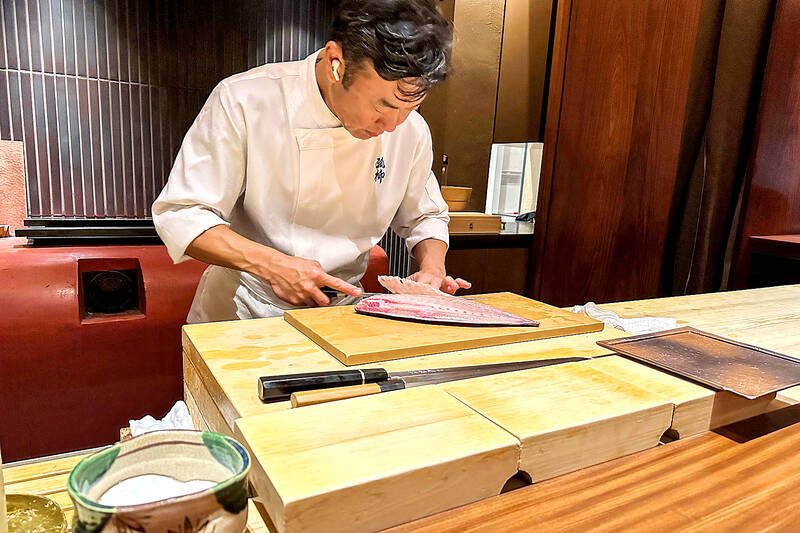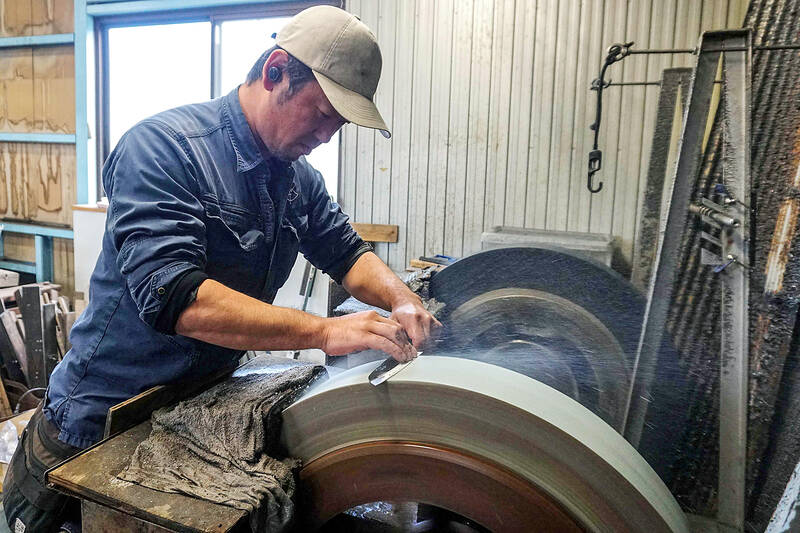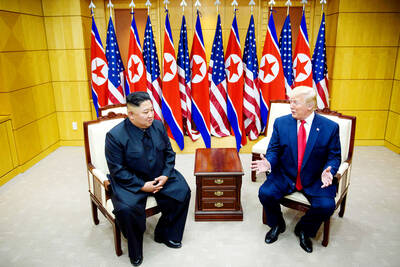Blacksmith Yoshihiro Yauji pulls a piece of glowing metal from the forge in a Japanese village, continuing a tradition dating back centuries to when the region was renowned for crafting swords carried by samurai.
He places the steel under a spring hammer and the sound of the metal being flattened and fortified into a kitchen knife echoes off the mountains surrounding the workshop.
“I believe that blades are the foundational root of Japanese culture,” 40-year-old Yauji said. “If you can condense 700 years, 1,000 years or 1,500 years of technology into a single product, the appeal of the product will be different,” he said, adding that at first, he wanted to make “katana” swords once wielded by samurai.

Photo: AFP
Yauji started at 20 as an apprentice to Hideo Kitaoka, who helped found the collection of cooperative workshops that make up the Takefu Knife Village. After 18 years, Yauji launched his knife line in 2021. But in the 1970s and 80s, the city of Echizen where the knife village is located was in crisis, with artisans unable to compete with cheaper mass-produced tools. Kitaoka and other top blacksmiths banded together to form a cooperative association and, with the help of famed designer Kazuo Kawasaki, began producing designs that turned Echizen knives into works of art.
“At the time of my boss’s generation, the environment was not like it is today; they were struggling just to survive,” Yauji said. “My generation is on the upswing. So I feel it is necessary to once again improve our skills for the brand and its value to continue to exist.”
Around 80 percent of Echizen-made knives are now exported, Yauji said, making their way into professional kitchens around the world and even featuring on hit TV series The Bear.

Photo: AFP
HAND FITS THE KNIFE
The forge at Takefu burns at 900 degrees Celsius, and the handmade Japanese blades drawn from the molten orange core, once hammered, shaped and polished, are sharp enough to split a hair.
“The Japanese knife brings out the best of ingredients. Texture, bitterness, sweetness,” Yauji said. “I think it is a knife specialized to bring out the true flavor of the ingredient itself.”
Knife makers can spend an entire day perfecting a single piece. The metal is heated until malleable and then hammered — a process repeated several times — before being shaped, quenched in oil or water and left to cool. Once the temperature is stable, it is ready to be sharpened. Most blacksmiths hand the knife over to dedicated sharpeners at this stage.
Then, the utensil is ready for the final step of the process: handle making.
“Japanese cutlery is, in my opinion, about the hands learning to fit the tool” instead of the knife being designed for the comfort of the user, Yauji said. “It is a way of trying to establish a deeper connection.”
‘SOUL OF A CHEF’
Using his custom-made yanagiba (willow-leaf blade) sashimi knife, Chef Shintaro Matsuo slices a buttery slab of fatty tuna at acclaimed Osaka restaurant Koryu, considered one of the best fine-dining establishments in a city dubbed Japan’s kitchen.
Matsuo’s dishes combine subtle flavors using ingredients from the surrounding Kansai region, all artfully presented with the help of blades made in Sakai, a small town on the outskirts of Osaka that is considered Japan’s hocho (kitchen knife) heartland.
“The knife is an extension of my hand,” the chef explained, proudly wielding the elongated blade specially made by blacksmith Minamoto Izumimasa.
“Japanese steel allows the flavours of the food to remain intact,” Matsuo added.
Chefs in the country spend years honing their knife skills and patiently learning to master blades that are often more challenging to use and require greater expertise.
“Japanese people have a unique sense of beauty when it comes to cutlery,” said Ryoyo Yamawaki, whose Sakai-based company has been making knives since 1929. “Since ancient times, the Japanese sword is said to have been the soul of a samurai, and the knife the soul of a chef.”

When Taiwan was battered by storms this summer, the only crumb of comfort I could take was knowing that some advice I’d drafted several weeks earlier had been correct. Regarding the Southern Cross-Island Highway (南橫公路), a spectacular high-elevation route connecting Taiwan’s southwest with the country’s southeast, I’d written: “The precarious existence of this road cannot be overstated; those hoping to drive or ride all the way across should have a backup plan.” As this article was going to press, the middle section of the highway, between Meishankou (梅山口) in Kaohsiung and Siangyang (向陽) in Taitung County, was still closed to outsiders

US President Donald Trump may have hoped for an impromptu talk with his old friend Kim Jong-un during a recent trip to Asia, but analysts say the increasingly emboldened North Korean despot had few good reasons to join the photo-op. Trump sent repeated overtures to Kim during his barnstorming tour of Asia, saying he was “100 percent” open to a meeting and even bucking decades of US policy by conceding that North Korea was “sort of a nuclear power.” But Pyongyang kept mum on the invitation, instead firing off missiles and sending its foreign minister to Russia and Belarus, with whom it

President William Lai (賴清德) has championed Taiwan as an “AI Island” — an artificial intelligence (AI) hub powering the global tech economy. But without major shifts in talent, funding and strategic direction, this vision risks becoming a static fortress: indispensable, yet immobile and vulnerable. It’s time to reframe Taiwan’s ambition. Time to move from a resource-rich AI island to an AI Armada. Why change metaphors? Because choosing the right metaphor shapes both understanding and strategy. The “AI Island” frames our national ambition as a static fortress that, while valuable, is still vulnerable and reactive. Shifting our metaphor to an “AI Armada”

The Chinese Communist Party (CCP) has a dystopian, radical and dangerous conception of itself. Few are aware of this very fundamental difference between how they view power and how the rest of the world does. Even those of us who have lived in China sometimes fall back into the trap of viewing it through the lens of the power relationships common throughout the rest of the world, instead of understanding the CCP as it conceives of itself. Broadly speaking, the concepts of the people, race, culture, civilization, nation, government and religion are separate, though often overlapping and intertwined. A government